Federal Reserve Bank of Boston
![]()
The Impact of Inflation
Winter 1997
by Rebecca Hellerstein
http://www.bos.frb.org/economic/nerr/rr1997/winter/hell97_1.htm reproduced with permission from the Federal Reserve Bank Of Boston.
Inflation is the most commonly used economic term in the popular media. A Nexis search in 1996 found 872,000 news stories over the past twenty years that used the word inflation. "Unemployment" ran a distant second. ¶ Public concern about inflation generally heats up in step with inflation itself. Though economists do not always agree about when inflation starts to interfere with market signals, the public tends to express serious alarm once the inflation rate rises above 5 or 6 percent. ¶ Public opinion polls show minimal concern about rising prices during the early 1960s, as inflation was low. Concern rose with inflation in the late 1960s and early 1970s. When inflation twice surged to double-digit levels in the mid and late 1970s, Americans named it public enemy number one. Since the late 1980s, public anxiety has abated along with inflation itself.
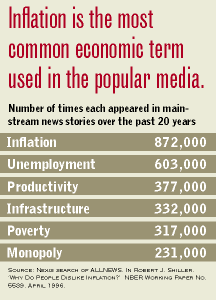
Yet even when inflation is low, Americans tend to perceive a morality tale in its effects. A recent survey by Yale economist Robert Shiller found that many Americans view differences in prices over time as a reflection of fundamental changes in the values of our society, rather than of purely economic forces.
Economists think of inflation more plainly as a "sustained rise in the general level of prices." Their concerns focus on questions such as whether inflation distorts economic decisions. Very high inflation adversely impacts economic performance, as evidence from cross-country studies shows. Likewise, moderate levels of inflation can distort investment and consumption decisions. Recent U.S. experience with low, stable levels of inflation, in the range of 2 to 3 percent, has spurred policy makers to consider the possibility of achieving zero percent inflation.
Reducing inflation however has costs in lost output and unemployment during the adjustment. Thus, an important question is whether zero percent inflation is sufficiently better for the economy than 2 to 3 percent inflation to warrant the effort of getting there.
PUBLIC PERCEPTIONS
Americans are most concerned that inflation may lower their standard of living -- that their incomes will not keep up with the rise in prices.
This anxiety is particularly pronounced for retirees, uneasy about inflation adjustments to their pensions and financial investments. To plan for retirement requires forming expectations of prices in the future. Inflation makes this more difficult because even a series of small, unanticipated increases in the general price level can significantly erode the real (adjusted for inflation) value of savings over time. Shiller finds that worry about inflation's costs increases dramatically as individuals near retirement age. Americans born before or after 1940 differ more in their evaluation of inflation's effects than do the U.S. and German populations as a whole.

Social Security payments are now indexed to inflation, a policy change that has reduced somewhat the effects of inflation uncertainty on retirement. Thus, anxiety now focuses more on savings in long- term maturities such as bonds and on employer pensions which typically are not indexed.
Concern about living standards also stems from the widespread belief that inflation pushes up prices before it pushes up wages. Many people understand prices rise because of inflation. But they seem to attribute nominal increases in their wages more to their own accomplishments than to the feedback effect of inflation.
To the extent that they acknowledge feedback effects, most Americans seem to believe in a "lagged wage-price" model of the economy. That is, they assume that price increases occur first and wage increases follow, often much later. Shiller's survey found a striking number of people -- ove 75 percent of respondents -- believe that their income would not fully adjust for several years after an inflationary episode. Economists have tried to measure whether wage increases lag price increases since the 1890s but have consistently found the relationship difficult to estimate.
Many people also dislike inflation because they feel it makes it easier for the government, employers, financial institutions, and others to deceive them. Thus, over 70 percent of Shiller's respondents agreed that "One of the most important things I don't like about inflation is that the confusion caused by price changes enables people to play tricks on me, at my expense." Thus, some employers may "forget" to raise their employees' wages as much as inflation thereby giving them a real pay cut.
There is evidence that people do get fooled, at least initially, about their real wages. Economists Peter Diamond, Eldar Shafir, and Amos Tversky argue in their recent paper, "On Money Illusion," that people seem to base their sense of satisfaction on nominal earnings, rather than real earnings. Similarly, Shiller found that over half of his respondents agreed with the statement that, "I think that if my pay went up I would feel more satisfaction in my job, more sense of fulfillment, even if prices went up just as much."
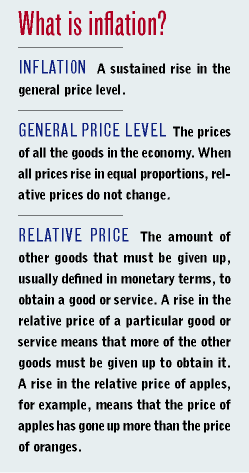
Inflation creates other opportunities for sophisticated institutions to unfairly take advantage of the average individual, in many people's minds. Inflation can increase the complexity of evaluating financial assets, from CDs and insurance policies to stocks and bonds. This shifts the distribution of power in the financial marketplace to the more sophisticated and knowledgeable actors to the detriment of the average person, in this view. Thus, the government might "forget" to change the tax brackets after an inflationary episode, so the average person would end up paying higher taxes.
Similar issues of getting confused or fooled can operate within firms. Some monetary policy makers have hypothesized that managers may be lulled into complacency about profits by increases in the general price level. In his testimony last year before Congress, Federal Reserve Board Chairman Alan Greenspan observed that firms' productivity may rise more quickly with price stability, as the "inability to pass cost increases through to higher prices provides a powerful incentive to firms to increase profit margins through innovation." Inflation thus may weaken our judgment about how well we are doing, both as individuals and as firms.
People's immediate concern is with how their incomes hold up with changes in their expenses. Businesses care about how the prices of their products do in relation to their costs. Americans' recent memory of high inflation stems from the 1970s, a time when changes in relative prices, specifically the spike in oil prices, combined with a rise in the general price level. This combination of relative and general price changes in the 1970s, in Shiller's view, confused many people's perception of inflation.
The two oil shocks did result in higher inflation. But equally damaging was the relative price change. Oil was used pervasively to fuel machinery and other technology operated by workers; so when the price of oil went up, the productivity of many American workers fell and their real wages shrank. People today may confuse the experiences of the 1970s -- falling wages, gas rationing, and the redistribution of income -- with the effects of any rise in the general price level.
Overall, Shiller's respondents uniformly view inflation as harmful -- that it lowers standards of living by pushing up prices before wages and pensions, and that it facilitates deceptive behavior. Because inflation may benefit some people, say by its redistribution of wealth from creditors to debtors, Shiller was surprised that not a single respondent mentioned any benefit gained due to inflation.
DISTORTED BEHAVIOR
Economists tend to emphasize that inflation can do economic damage by distorting investment and consumption decisions. Distortions result first from households' and businesses' uncertainty about inflation's future course, and second from inflation's interaction with the U.S. tax code.
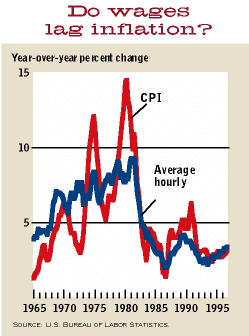
Inflation's interaction with personal income taxes, for example, can distort decisions about how much income to spend on housing. This interaction plays out with owner-occupied housing, where mortgage interest payments are deductible. Inflation gets built into nominal interest rates; so even a moderate rise in the price level increases this deduction. And housing services, that represent part of the return to housing investment, escape taxation. Moderate to high inflation thus prompts households to spend more on housing than would be optimal in a low-inflation environment.
Thus, the real estate boom in the 1970s was fueled in part by inflation-induced distortions, wrote Lynn Browne of the Boston Fed. High rates of inflation accelerated home buying by increasing the real, after-tax returns to investment in owner-occupied housing relative to alternative investments. A lag in interest rates reinforced this uptick in demand. As house prices in turn began to rise faster than the general price level, people rushed to buy rather than face higher prices later.
These distortions in the housing market reverberated across other markets. In the forestry industry, for example, housing starts are watched closely to project future sales. Many firms responded to the housing boom in the mid-1970s by expanding sawmill capacity. The St. Regis Corporation, now a subsidiary of Champion International, based in Stamford, Connecticut, decided in the mid-1970s to build a sawmill in Costigan, Maine. The sawmill initially did poorly, as it came on-line when the housing market's boom turned to bust. Vice President Bob Turner recalls that the Costigan mill lost money through the early 1980s, in part because of the firm's misperceptions about future demand.
Distortions in economic activity also may result from the uncertainty that arises about inflation's future course. When inflation is stable, people are more likely to have roughly the same anticipation of its future level. When inflation is highly volatile, however, people have different guesses. Most turn out to be wrong. Inadvertently, some end up winners and others losers.

This occurs whether inflation's level goes up or down. Among the losers in the early 1980s were numerous small mills in the forestry industry. These mills bid for timber based on the assumption that inflation would continue to be high. These bids, made primarily for United States Forest Service timber, locked in prices between the purchase and harvest date, usually three to five years.
After 1981, when inflation fell dramatically, the real cost of such contracts rose significantly, leaving many firms with contracts for timber they could not afford to harvest. Forestry lobbyists argued that the difficulty in anticipating the dramatic fall of inflation in the early 1980s justified their release from the contractual obligation. In an unusual move, Congress passed a bill, in the early 1980s, directing the Forest Service to renegotiate all timber contracts from the late 1970s, to minimize their impact on small forestry companies.
The congressional bailout was highly unusual. Most contracts are not renegotiated. Thus, when inflation is unanticipated, businesses' relative prices can be distorted either because contracts are set and not renegotiated or because it takes time for firms to distinguish between relative and general price changes. This makes it difficult for businesses to invest in a high inflation environment, where relative prices are variable. Firms may misinterpret the ability to raise their product's price as stemming from an increase in demand for their good relative to others, and invest too much. Or they may be less confident that they will earn a return sufficient to pay off debt, and thus may curtail investment.
Uncertainty is always present in markets, of course. No one can predict the future. To the extent that inflation even at low levels adds to this general uncertainty, it is costly.
IS ZERO THE MAGIC NUMBER?
Does the fact that inflation can be costly mean zero inflation is optimal? Many economists and policy makers argue that zero inflation would allow consumers and firms to write simpler contracts and make long-term plans for retirement or future investment with less worry. The debate focuses on two questions: first, whether the costs of getting to zero inflation outweigh the benefits of being there; and second, whether there are significant costs as well as benefits to being at zero inflation.
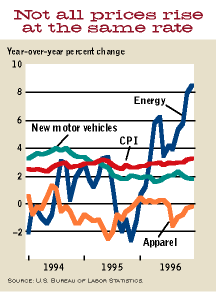
|
|
The textbook model and aggregate measures of inflation imply a smooth,
uniform rise of the general price level. But in fact, inflation moves
through relative price changes across industries. In some sectors, such
as energy, the rise and fall in prices can be mercurial. Only in the
aggregate do rises in the general price level appear even and regular over time.
|
Getting to zero inflation can be costly, involving lost output and higher unemployment during the transition. Some economists argue that the costs of getting to zero may be greater than the benefits of being there. They point to the six post WWII episodes in which inflation came down significantly and note that output fell each time. Reducing inflation lowers output and raises unemployment during the adjustment because wages and prices are slow to respond, in this view.
Many of those who argue for zero inflation emphasize that little sacrifice in unemployment or lost output is necessary if the central bank makes credible statements about the intended disinflation, and the public believes these declarations and incorporates them into its plans. In his recent book, Macroeconomic Policy in a World Economy, Stanford economist John Taylor argues that the reductions in output necessary to achieve zero inflation are smaller than suggested by traditional models. The problem with traditional estimates, writes Taylor, is their failure to account for the effects of credibility gaps in past disinflations by the Federal Reserve.
Harvard economist Martin Feldstein argues that the costs of a disinflation from 2 percent to zero percent inflation would be far outweighed by the long-term benefits. These arise, Feldstein argues, because even low rates of inflation exacerbate the biases in favor of current consumption and owner-occupied housing created by our tax system.
Others claim that zero inflation has costs of its own. A recent Brookings Institution paper by George Akerlof, William Dickens, and George Perry argues that moderate inflation yields significant efficiency gains by "greasing" the wheels of the labor market. Firms use inflation to "cover" adjustments in real wages and at zero inflation nominal wage cuts, never popular among workers, would necessarily be more common. The difficulty of adjusting real wages in the absence of moderate inflation has cumulative negative effects, they claim, including permanently higher unemployment and lost output. This argument, while interesting, is nevertheless controversial and evidence from labor market studies by David Card, Dean Hyslop, and others does not confirm the potential for such clear efficiency gains from the presence of moderate inflation.
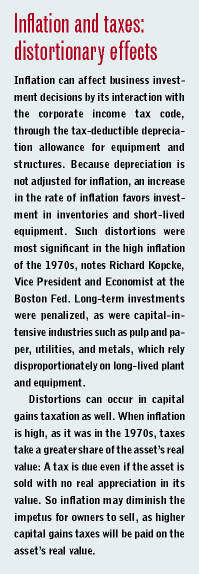
Another argument against zero inflation is the risk of deflation, a drop in the nominal price level, which could be quite costly to the degree that some prices and wages might not easily adjust downward. From the late nineteenth century until World War II, long downward trends in the price level and shorter periods of falling price levels were common in the industrialized world. But they were generally associated with falling output and rising unemployment. Declines in the general price level have been rare in industrialized countries since the end of World War II, although Sweden did sustain a mild deflation in 1996 with few apparent negative consequences.
Larger deflations could be more costly, notes Princeton economist Ben Bernanke, in part because the potential for deflation is not written into most contracts. Interest rates cannot be negative, so the real interest rate can quickly become high when nominal prices are falling. And the ability of monetary policy to respond to recessionary shocks may be constrained. Some cite Japan's recent experience as an example of how low nominal interest rates (close to zero) were less stimulative than might be expected because prices were falling.
MONEY AND MORALS
The debate among policy makers and economists on inflation's impact at 3 percent versus zero percent is quite vigorous, at present, but no clear consensus has been reached. What the public believes is also unclear. Opinion polls since World War II consistently show that Americans regard inflation as a more serious problem than unemployment. Evidence from a number of public opinion surveys is contradictory, however, on whether the public would be willing, if necessary, to sustain higher levels of unemployment and a loss of output to achieve price stability.
What the public believes about inflation matters because such beliefs affect the economy's performance. Once inflation has become embedded in economic behavior, it has been quite difficult to remove its influence. Whether the initial cause is a supply shock, such as the oil crisis in the 1970s, or a demand shock, such as the increased spending on the Vietnam war in the late 1960s, individuals come to expect inflation and incorporate these expectations into their plans. By reinforcing the original change in inflation's level, notes Johns Hopkins economist Laurence Ball, public expectations become one of the chief causes of inflation's persistence in the economy.
Letting inflation creep up also threatens to erode public faith in the reliability of political leaders. All the nominal contracts we have today were made possible through trust that the government would not allow massive inflation. Americans' feeling of pride in national institutions depends in part on low inflation or "sound money" as a signal of healthy fiscal and monetary institutions.
Finally, inflation can discourage saving and encourage consumption. It thus is perceived as an attack on certain moral virtues -- a strong work ethic, deferred gratification -- that support a healthy economy. John Maynard Keynes made his famous attack on the Victorian virtue of saving -- always "jam tomorrow and never jam today" -- for economic reasons. Consumption in a depression or a recession could strengthen the economy, in his view. But British society took Keynes's mockery as an assault on the core of Victorian morality. Many Americans likewise feel that inflation assaults the legacy here of the Protestant work ethic that places a moral premium on saving over consumption. Fighting inflation thus is seen by many as a moral as much as an economic duty. Americans want their public officials to fight inflation to increase long-term output and employment but perhaps also to strengthen society's moral foundation.

Author: Colin Twiggs is a former investment banker with almost 40 years of experience in financial markets. He co-founded Incredible Charts and writes the popular Trading Diary and Patient Investor newsletters.
Using a top-down approach, Colin identifies key macro trends in the global economy before evaluating selected opportunities using a combination of fundamental and technical analysis.
Focusing on interest rates and financial market liquidity as primary drivers of the economic cycle, he warned of the 2008/2009 and 2020 bear markets well ahead of actual events.
He founded PVT Capital (AFSL No. 546090) in May 2023, which offers investment strategy and advice to wholesale clients.
